Dolphin Coast Story
Dolphin Coast Challenge - Unchartered Waters, November 2001
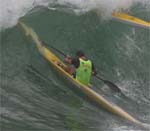 [Editor: Wayne Borchardt wrote this article after the 2001 Dolphin Coast challenge. I think it describes perfectly the viewpoint of less-than-elite Cape paddlers tackling the Durban coastline. I couldn't get photos of the 2001 event itself so I've used shots from the 2006 Scottburgh to Brighton.]
[Editor: Wayne Borchardt wrote this article after the 2001 Dolphin Coast challenge. I think it describes perfectly the viewpoint of less-than-elite Cape paddlers tackling the Durban coastline. I couldn't get photos of the 2001 event itself so I've used shots from the 2006 Scottburgh to Brighton.]
One could question our preparation for the Dolphin Coast Challenge. A mere 2-week graduation course from a Hammerhead to a Fenn was not exactly the tonic needed to steady our nerves. The only aspect that we were confident of was our ability to fall out of the Fenn seemingly at will. A flavour of what was in store for us came in the form of a seemingly innocuous question during the pre-race banter: "so how much big wave experience have you guys had?"
Day 1: Zinkwazi to Salt Rock
32km, launch from Zinkwazi at 10h00, almost exactly spring low tide. Zinkwazi parking area was a hive of activity: final duct-taping, tripper filling, suntan lotion smearing, and, most importantly, surveying the surf line and suggesting launching strategies. Huge surf was rolling in relentlessly. Breaking waves stretched back as far as we could see. The back line of the surf was not evident. Our own fear was reflected in the faces of many of the experienced, sea-hardened paddlers.
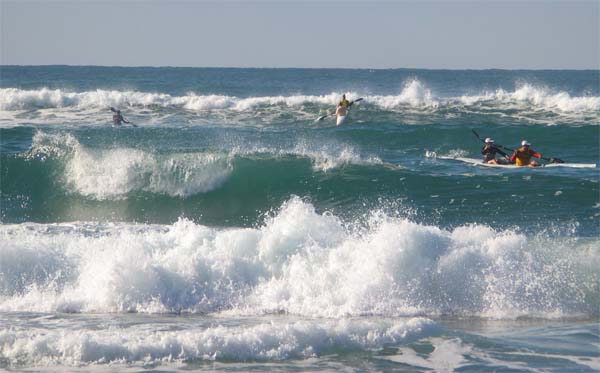
Carrying the boats to the launch spot on the beach we had to cross a fast flowing river. Yip, the "camel adventure" had begun. We lay our boat on the beach and watched in fascination and horror as the first wave (mixed doubles) was set off. Carnage! While one ski seemed to escape somewhat unscathed (they swam once), all the others were capsized and washed far down in the Zinkwazi bay by the huge rip.
The mixed doubles were still trying to recover from their initial thrashing when the singles were set off 10 minutes later. With legends like Herman Chalupsky it was no surprise to see some boats successfully make their way through the angry surf and beyond the back line. Other experienced and talented paddlers, Anthony Pearce and Paul Lange for example, were beaten badly. I think Anthony had to make 4 attempts before he secured a passage to the outside. Paul lost his juice on his first encounter with a big wave. But, he continued, seemingly unperturbed, and made it out for the 3-hour race with no liquid.
Evan and I were wearing "camel-back" type drink carriers while most of the other paddlers had secured trippers to their boats. Shortly before we due to go, we were advised that our setup was a very bad idea since, if we swam (which was inevitable after seeing "how the mighty had fallen" ahead of us), we'd be hindered by these bags. So, at the last minute, we tried to secure our backpacks to the boat.
And now we were off!! Many of the singles and some of the doubles had still not made it through the surf. For Evan and I it was our first time paddling through serious surf. We'd been given all the tips: lean back to get over the foamies, keep the boat perpendicular to the wave, hold the boat upside down by the foot straps when confronted by a huge wave. We had made it over one or two waves before we were knocked over. We hopped back in. Actually, to say hopped back in is too kind - our technique for getting back in the boat requires much improvement: I tend to lie straddled over the boat like a turtle and Evan gets in facing backwards - a real Laurel and Hardy show. Anyhow, after a couple of swims Evan decided he'd rather have his drink on his back again and proceeded to detach it from the boat. So, now we're back in the boat and making some headway, perhaps even getting closer to the backline; we could at least see the shark net buoys. It's very difficult to know where the backline is, since each time we crest a wave we see more waves looming.
We powered successfully through a big wave, almost becoming entirely airborne and the boat dropped back down, shuddering. But then ... it was almost like it became dark - the biggest wave of the day (and it gets bigger every time I tell this story) loomed over us and then crashed down upon us. I'm sure I heard Evan scream, but it might have been my own. Tossed out of the boat and pulled under and winded by the force of the wave I struggled to swim up to the surface. Gasping for air, I broke through the remaining white water and saw Evan had surfaced too, some distance away. "Deer trapped in the headlights" looks all round. The boat had been carried all the way back to the beach. We started the long swim back in. I kept an eye on Evan since I could see he was struggling with his backpack pulling him down. It probably took us more than 10 minutes to reach the beach and recover the boat. I was bleeding from my ankle and I still have no idea how that happened. I had also received a solid punch from the boat in my mouth on one of our earlier swims.
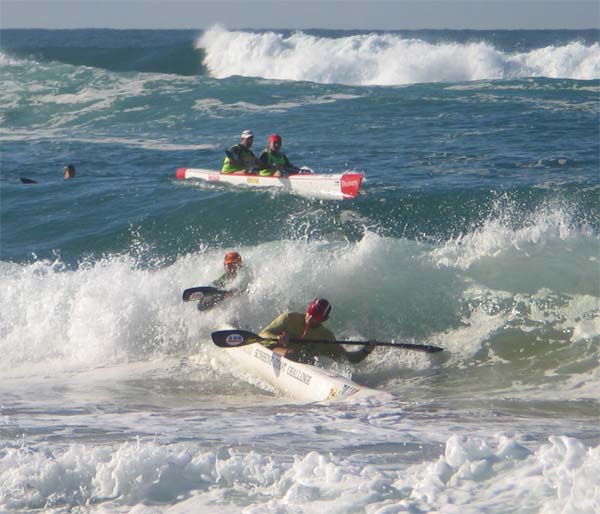
Later, Evan told me that he had registered 200 on his heart rate monitor. Even under the whip of Martin Dreyer's interval training sessions, Evan has barely hit 160 when paddling. Adrenaline?
So, battered and bruised, and battle-weary, we carried the boat back to where we had launched. We had been washed some 400 metres down the beach by the side rip. Back at the launch spot we were advised (a) that the best spot to launch is right by the rocks, where the river runs into the sea, and (b) that the officials were only allowing us one hour to make the launch successfully otherwise we would be forced to retire. We made several attempts, three or four times, each time being swept back to the beach. On our last attempt one of the other men's doubles was in trouble too. They got thrown and one of the paddlers was calling for assistance. He'd cramped in his hamstring and could not swim in. I swam to his assistance and took him in a lifesaving grip, i.e. turned him on his back and brought my arm under his and around his chest to swim him in. Now I'm not in the habit of putting my arm around men and I was astounded by the sheer girth of this man's chest - I could barely reach his sternum from behind. Also, this guy was solid muscle - and it felt pretty weird to be hugging someone more built than me. No, not that I consider myself built, but it is women that I'm used to holding (and they're much softer and more cuddly). Very quickly we were back in standing depth water and the grisly man was able to look after himself.
The organisers sounded the siren and we and the guy I had rescued were forced to retire. We'd spent 1 hour being beaten by the biggest surf I'd ever tried to contend with. In truth, Evan and I were somewhat relieved, although very frustrated, that we'd been asked to retire. Had we made out to the backline at that time, I probably would not have had the energy to complete the paddle. We were broken, pissed-off and exhausted. In all, 8 of the fifty-something boats retired on Day 1.
Evan and I spent the remainder of the day alternating between beating ourselves up for our incompetence and strategising for Day 2. Actually, Day 2 was more important since it was the leg that counted in terms of qualifying for the Cape Point Challenge - our ultimate surfski goal for this year. Day 2 would be 42km. We spent the rest of the day hearing the war stories and success stories from our Cape Town comrades: amongst others - Andrew Sneddon's seasickness 2 hours into the race and Martin Coetzee's luxury ride in the back of the boat with sea-dog Billy. We asked everyone for advice and we built up our resolve to make Day 2 a success. I surveyed the sea every hour that afternoon and continued encouraging the north-easter to blow since it would settle the surf.
Day 2: Salt Rock to Durban.
It gets light in Durban at some ridiculous hour close to 4am. So by 5am Evan and I were on the beach surveying the launch spot for Day 2's race. It seemed that the surf had dropped somewhat - well, irrespective, we convinced ourselves that it had. The uncertainty was how the surf would have changed by 9am since this was spring tide and a beach break is highly subject to tidal fluctuations.
Leading up to 9am was the pre-race activity. Our main objectives were to be adequately sun-screen protected (it was going to be a hot day), ensure that our juice was firmly duct-taped to our boat and to identify an appropriate launch strategy. In fact, in our eagerness to know how to launch, we completely overlooked trying to gain an understanding of what to do, e.g. which way to head, once we made it past the backline.
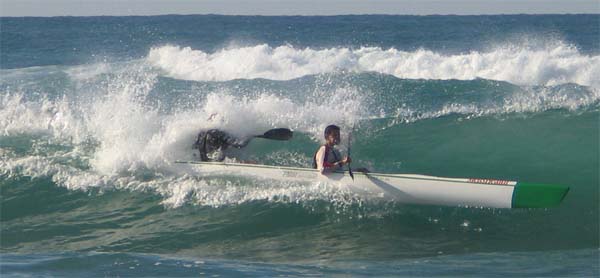
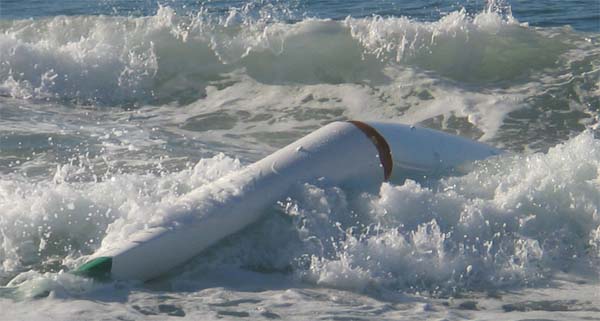
So, once again lined up and ready for the start. Evan and I wondered around and struck up conversation with others to get advice. Evan spoke to Herman who assured him that there wasn't a wave coming through today that we couldn't just punch through. Yeah right, Herman - maybe nothing that you can't easily get through.
Once again, we got to see the other categories head off first. Carnage again! The side rip drew several boats onto the rocks and some were broken. Waves were pounding skis. I saw one ski shoot vertically into the sky, naturally without its poor paddler, pirouette and drop back down. Evan and I were determined that we were going to make it today. In fact, as the official came around to take our boat number (for safety purposes), I told him that they had better be prepared to hang around until we made it out today, because today there would be no throwing in of the towel. He just smiled knowingly.
Just before our wave was set off I saw a school of dolphins on the backline. This was a good omen - no, not just because I think dolphins are great, but also because we could actually see the backline this time. And off we went. Evan and I chose to err on the aggressive, rather than the conservative (which was yesterday's failed strategy), approach and we charged out the gates. We powered through the beach break and the middle break foamies and the outer waves of the backline were immediately in sight. We kept a rapid paddling cadence and cleared the backline. Triumphant, paddles thrust into the air to signal our supporters on the beach that we had made it. But what now?
We took a diagonal route out and kept a lookout for other boats. Evan is convinced that we made it out first. We might well have. I was so focused on keeping my eyes on the waves I had seen no one else. Anyhow, after a few minutes of paddling, Evan spotted another boat. We pulled alongside and asked what heading they were taking. For the uninitiated - you need to understand that when you're out beyond the backline in the heaving ocean off Durban's coastline, you're on your own. The coast is distant, the swells are massive and the sea is a vast, moving expanse of wind-whipped peaks and valleys. The wind generates huge non-breaking waves. Surf skis are built to ride these waves. When you position the ski with the wind on your back and the waves running with the wind, huge craters develop in front of you. Solid paddling and you're hurtling down the wave at an awesome speed. We were advised not to look back - it's kind of like when you're climbing and looking down is more than a little daunting. When the wave is really big and steep, the nose often ploughs into the valley sending a shower of water over the boat. Big waves create what some of the paddlers call "mineshafts".
We managed to get onto the runs (riding these waves) very successfully and we made excellent time for the first 2 hours. I won't bore you with the account of our dismal feeding attempts - Evan diving to save half a banana, our usual stunts in getting back into the boat, me launching myself into the boat from the one side with so much force that I sprung right over and back into the sea on the other side. At about one and a half hours we spotted a built section on the coast some way away. Durban? Well, so we thought (remember we're from Cape Town). In 2 hours we had reached our Durban - amazed and impressed, until we realised that there was an even bigger set of buildings in the distance. Our Durban was, of course, Umhlanga (Widely acknowledged as the first Zulu word a Sandton kugel learns) - a good 12km from the finish point. Although we'd been paddling well to this point I was starting to take strain - I was tired all over, my calf muscle kept threatening to cramp and my hands were developing blisters.
But, on we forged, heading back out to sea in the direction of Durban. I'm not sure quite how it happened but for some reason we ended up taking a very inefficient line. By the time we were lined up with Durban we must have been about 5km from the coast. Our paddling was slowing, our balance was worsening and my enjoyment of this race was rapidly ebbing. We had no idea where to aim for, which beach to come in on. Actually that was less of a problem than it felt since we were so far from land we could have equally headed for any of Durban's beaches.
So we opted to point the boat towards the shore and paddle in. The wind and the sea were in our favour but still the coast didn't seem to be getting any closer. We paddled and paddled and fell in and paddled and ... on it goes. At one point a dolphin popped out of the water just next to us. That served to lighten my spirits. Now we were getting closer to the coast. In fact, yes, I could make out what appeared to be surf-skis on the beach. We paddled and paddled. And now we could start to see the colour of the water change and then the shark nets. We were almost there. And, we had a strategy for getting in without further trauma. It's simple, just follow a big wave in as fast as you can. Hmmmm. Not so easy in practice. We move in beyond the backline, ready to follow our wave in and, once again a shadow fell over us. A huge wave (actually much smaller than the Day 1 monster) loomed over us. Evan abandoned ship. I didn't even know he had since he sits behind, but he told me later on the beach. The wave crashed down and ripped the boat away. Here we go - déjà vu - but my consolation was that we were almost home and although the boat was being bounced by the wave, it was heading in the right direction.
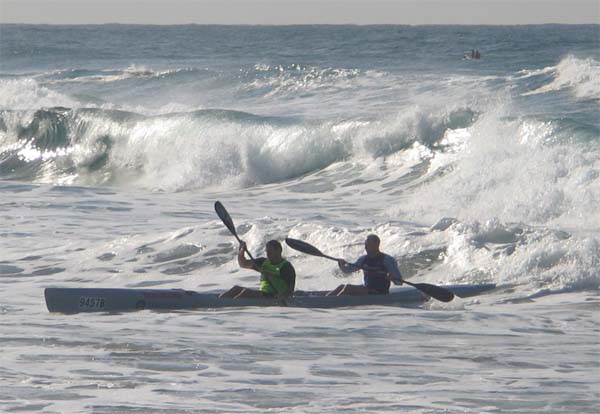
My calf cramped completely at this point, but I wasn't too concerned because I'm reasonably confident of my swimming abilities, even without one functioning leg. Evan reached the boat first, after we'd both swum about 200m toward the shore. We hopped back in again, actually this time a little more elegantly than usual, and paddled the remaining 50m into the beach. We'd done it! We had completed the arduous second leg of the Dolphin Coast Challenge and qualified for the Cape Point Challenge. Hmmm - Cape Point is twice as long, do we really want to do that?

